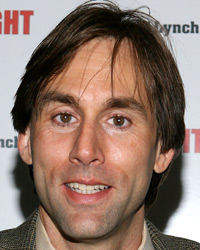Erik Weihenmayer
American mountain climber (1968 - )

- || At The Bottom
1981 -- Erik Weihenmayer would not be able to look forward to the same sorts of teenage experiences his friends would enjoy. Diagnosed with a rare eye disease called retinoschisis ten years earlier, the 13-year-old Weihenmayer was losing his last remaining bit of sight as his retinas slowly split. Doctors were powerless to stop the slow progress of the disease. "Each morning," he wrote in his memoir," I woke up to a new level of diminished vision and the lessened expectations that went with it." His world was shrinking each day, but he had no idea when his retinas would finally give way to the pressure building up behind them. The world he saw was filled with "dim, dark shapes" that hovered on the periphery of his vision. "Nothing I saw was real and, as my vision flickered, I imagined monsters with scaly bodies and bulging eyes waiting just out of view." By the time he turned 14, his vision was completely gone.
- || At The Top
2001 -- Erik Weihenmayer slowly ascended up the dreaded Hillary Step, the narrow 40-foot rock face that separated climbers from access to the true summit of Mt. Everest. Tibet lay 10,000 feet below him on one side; Nepal was a slightly closer 7,000 feet below on the other side. The slightest misstep would send him tumbling into one country or another, but Weihenmayer made it along with 18 other climbers in May 2001. It was not the first major summit of his life. He had already scaled Mt. McKinley in 1995, El Capitan (in Yosemite National Park) in 1996, Mt. Kilimanjaro in 1997, Argentina's Aconcagua in 1999 and Polar Circus -- a 3000-foot-tall ice waterfall in Canada's Banff National Park -- in 2000. At the age of 34, Weihenmayer became one of the small number of individuals -- less than 100 total -- who have climbed the "Seven Summits," the tallest peaks on all seven continents. Widely sought as a motivational speaker, Weihenmayer also authored Touch the Top of the World, a popular memoir and account of his Everest climb.
- || The Comeback
When Weihenmayer was in the last stages of losing his vision, he learned about the Canadian runner Terry Fox, who had lost his right leg to cancer and yet had embarked on a mission to run across the continent. A national hero in Canada, Fox's story served as inspiration to Weihenmayer, who decided to take up the sport of wrestling not long after total blindness set in. He continued to wrestle while attending Boston College, but he soon wandered toward a new interest in climbing. As he told an interviewer in 2004, his blindness actually challenged him to do more with his life than he otherwise might have. "One thing that blindness enables you to do in the modern world is to be more of a pioneer," he explained. "I don't want to sound nostalgic, but it's exciting to be the first to see if it can be done. That's 50 percent of the reason why I find things exciting." Blindness, he added, "isn't a death sentence. Everything you need is inside you."



